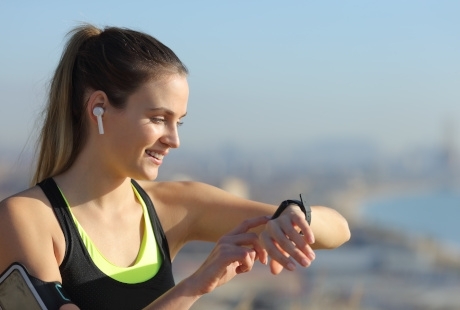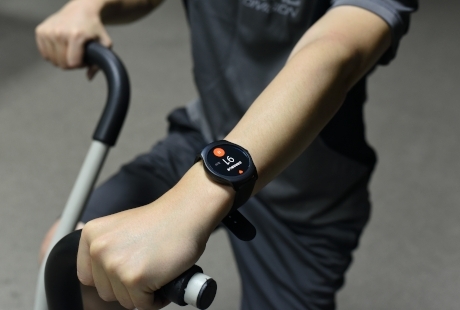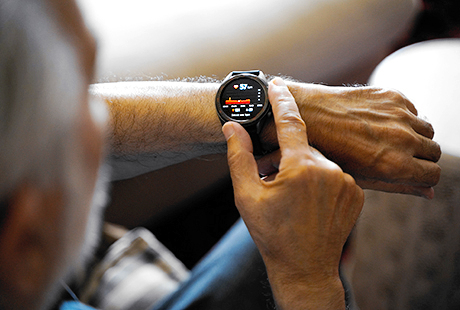- Home
- Applications
- Wearables & Hearables
- Personal Health Management
Wearables & Hearables
Optical PPG Sensor
PixArt's PPG (Photoplethysmography) Sensors incorporate powerful technology which is suitable for personal health management applications through electronic carriers or wearables including ear buds, arm bands, smart clothing, smart watches, fitness bands and smart PPG bands.
PixArt's PPG sensors is applicable to wearable/hearable/portable devices, to support health management applications such as continuous heart rate monitoring, static heart rate variability, static respiratory detection, static SpO2 monitoring, and sleep-monitoring. These bio-sensing data can be collected and analyzed to provide users with personal health information including long-term stress-level, sleep quality and workout program suggestions, and assist users to meet their health management goals.
Below are the common health management applications which PixArt's various PPG sensors can potentially support.
1. Heart Rate Monitoring
The American Heart Association has emphasized the importance of heart rate monitoring during workout, as it provides an objective feedback as to whether the exercise intensity level is considered safe or is enough to improve body fitness over time ("Know Your Target Heart Rates for Exercise, Losing Weight and Health," n.d., retrieved from https://www.heart.org/en/healthy-living/fitness/fitness-basics/target-heart-rates). In the latest health trends, many high-end PPG sensors are able to return their detected vital information to users, including static heart rate, exercising heart rate with motion compensation, exercise intensity zone suggestion, lactate threshold for aerobic/anaerobic workouts and estimation for maximal oxygen intake (VO2 max).
2. Workout Program Suggestion
The target heart rate during exercise, as defined by the American Heart Association, should fall between 50 to 85 percent of each person’s maximum heart rate. Although the exact value varies with body condition, the information does help to indicate the range of physical challenge that is considered safe for each individual.
Exceeding the target heart rate can be dangerous during workout as the person can become susceptible to cardiovascular or bone injuries. A PPG sensor that monitors and returns heart rate variation and vascular state can help to reduce such risk and provides useful prompts to the user who may wish to maintain target heart rate throughout the workout.
3. Stress Level Assessment (via HRV Metrics including SDNN data)
A stressful lifestyle is highly likely to affect one’s entire heart rate variability (HRV) and may further reflected by a less promising SDNN (standard deviation of all normal to normal intervals) test result. Generally a low entire-HRV (SDNN) is an indicator of autonomic dysfunction and a potential sign of poor health.
With PPG sensors that support HRV and SDNN readings, users can monitor their day-to-day mental stress level to make healthier adjustments. A low SDNN reading for consecutive days may indicate that the person has experienced overwhelming stress over a period of time, and can potentially suffer from chronic stress syndrome if his/her SDNN level fails to return to a higher level after sufficient rest or a holiday getaway. The functions encourage continuous self-monitoring routine for mind and body well-being, and help to raise awareness to abnormalities for early medical interventions.
4. Respiratory Rate Monitoring and Training
Slower and deeper breathing is proven to help reducing heart rate and blood pressure. Medical studies show that the ideal breathing rate (from 6 to 10 brpm) helps to improve cardiovascular functions and stimulate senses of calmness, relaxation and well-being over time.
With the respiratory training function derivable from PixArt's PPG sensor, users may be guided by auto-feedback prompts to help them keeping up with the ideal respiration rate. The technology can be deployed on large respiratory training systems or wearable devices to promote healthy lifestyles through each and every inhale and exhale.
PixArt’s PPG sensors are available as total solutions. The highly integrated PPG sensors are designed to deliver readily available PPG functions such as AGC (Automatic Gain Control), AEC (Automatic Exposure Control), auto LED control and auto ambient interference suppression. Additional hardware and software support including referencing mechanical designs and drivers may be provided upon request to assist future project implementation.
You may refer to the product pages below for more information. For potential PPG applications or projects that you may want to discuss with us, please feel free to contact us via our online support forms via SUPPORT.
Related Products:
- PAH8011ET-IP (wearables)
- PAH8011ES-IN (wearables)
- PAH8112ET-IT (portables)
- PAH8133HU-IN (hearables)
- PAH8132HU-IN (wearables)
- PAH8136HU-IN (wearables)
- PAH8151HU-IN (wearables)
- PAH8311LS-IN (wearables/hand-held ECG monitor)
- PAH8316LS-IN (wearables)
Electrical ECG Sensor
PixArt's ECG (Electrocardiography) sensor utilizes high-sensitivity ECG sensing technology, enabling users to measure and record cardiac electrical activity using various devices and wearables (such as smartwatches, health bracelets, or health monitoring rings). This capability to detect abnormalities in cardiac electrical conduction activity provides insights into cardiovascular health levels and the ability to distinguish between different heart diseases.
PixArt's ECG sensor is designed to capture, analyze, and record the heart's electrical activity while the skin spanning the two ends of the heart is in contact, forming a closed loop. The collected data helps users better understand their physical health status, including indicators such as atrial fibrillation, stress levels, and real-time heart rate, assisting them in achieving their long-term personal health management goals.
Some common applications of PixArt's ECG sensor are listed below.
1. Atrial Fibrillation Assessment
Atrial fibrillation is a condition characterized by an irregular and often rapid heart rate due to abnormal electrical signals in the heart. By integrating PixArt's ECG sensor with an atrial fibrillation assessment algorithm, the device can promptly assess the situation and provide appropriate advice to users experiencing palpitations, chest tightness, or chest pain. Healthcare professionals may also refer to the relevant data records for further diagnosis.
2. Blood Pressure Assessment
A PixArt ECG solution equipped with PPG sensors can output blood pressure values by simultaneously capturing and deriving ECG and PPG signals. This function enables users to easily measure and track their blood pressure anytime, facilitating long-term tracking of their blood pressure. The relevant records can also be provided to healthcare professionals as a reference to obtain more precise and tailored medical advice.
3. Stress Level Assessment (through heart rate and HRV index)
Generally, heart rate and its variability can serve as effective indicators of a person's autonomic nervous system function. The PixArt ECG sensor is capable of providing a comprehensive indicator by monitoring heart rate variability and electrocardiogram signals. This feature not only helps users track their stress levels but prompts them to seek professional diagnosis if any abnormalities are detected.
4. Real-time heart rate monitoring
PixArt's ECG sensor can be designed to measure the user's real-time resting heart rate and provide a variety of physiological reference information through advanced algorithms. This includes recommendations for exercise intensity level, lactate threshold for aerobic/anaerobic training, and maximum oxygen uptake (VO2 max).
We can create a complete health monitoring solution for customers and users, which involves designing highly integrated ECG and PPG sensors. Moreover, we can offer additional hardware or software support tailored to specific application needs, such as providing mechanical design suggestions, developing drivers, and optimizing application algorithms. For more details, please visit the comprehensive product page below.
If you would like to discuss potential applications or projects related to our ECG sensors, we welcome you to contact us via the online form under our "Support" menu.
Related Products:
- PAH8311LS-IN (wearables/hand-held ECG monitor)




